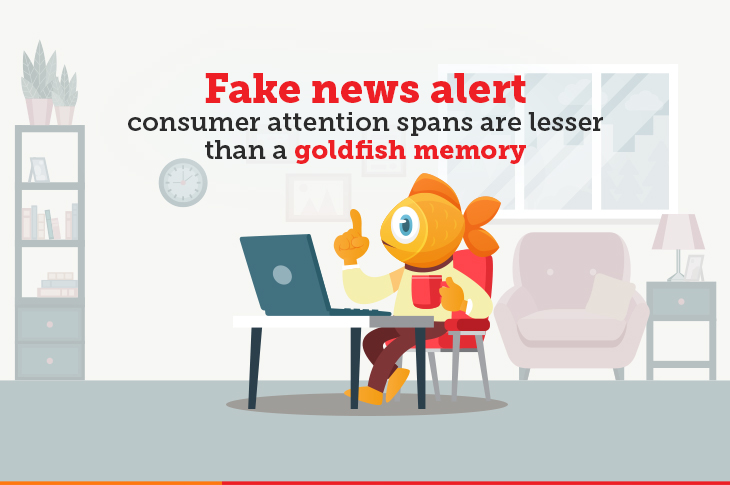Fake news alert – consumer attention spans are shorter than a goldfish memory

Ever heard of illusory truth? Wikipedia explains it as a tendency to believe false information as correct after repeated exposure. With marketer after marketer making the point of consumer attention span being less than the memory of a goldfish, some of us may be forgiven for believing this ‘research-led insight’ as gospel truth.
But truth be told, there’s something very fishy about comparing consumer attention to a goldfish. For a community that preaches the effective use of context in marketing, goldfish memory and the consumer attention span are used horribly out of context, and unfortunately not fact-checked.
Curiosity caught the fish
Two years ago, I attended the content marketing magnum opus event, Content Marketing World. Andrew Davis delivered one of the best keynotes I have witnessed, and he made three very valuable points:
- Quit blaming the goldfish. He said, “Our audience is capable of paying attention as long as we GRAB and HOLD the consumer attention.”
- The second point was concerning audiences not having time. He countered that by saying “Our audience will MAKE TIME to consume content that maintains their INTEREST.”
- About fifteen minutes into the keynote, he referred to the curiosity gap. He drew this on a large white sheet where the left side had a box called ‘what you know’. On the far right of the white sheet, he drew another box called ‘what you want to know’. The gap – or void, as he acknowledges – between these boxes was the curiosity gap.
You can see the first fifteen minutes of the keynote here. My takeaway from the keynote was this curiosity gap could be expanded from a goldfish’s memory to that of an elephant’s memory. It’s how the marketers and content marketing chooses to exploit the void.
Don’t bite the bait
I worry about marketers who make sexy and tweetable statements that border on the extreme fringes. Statements like ‘all content will be video in 20xx’ or ‘nobody reads long-form content’ or ‘email marketing is dead’ make me cringe. The tale of the goldfish’s eight-second memory belongs in the same league.
I was on a content marketing panel discussion earlier this year with some top marketers, and the goldfish swam around in our conversation. One of the panelists bit the bait by making a point that only short-form content will rule. However, I always felt that wasn’t true, and ever since I’ve been meaning to write this blog post. The COVID-19 lockdown and work-from-home allowed me to make a more detailed case.
Get off the hook
I decided to look for details about the goldfish report, but search after search told me no such thing existed. Instead, most searches pointed to such a report not being there – more often, it featured as a busted myth. Results such as this BBC report, this WSJ article, and more would have instantly stopped you from making what could be a debatable statement or working on a content marketing strategy with the goldfish lurking in the marketing team’s mind.

Cast the net
The larger point I want to make is that your content marketing needs to be more holistic and versatile. Content length and formats depend on the topic, device, platform, and where the consumer is likely to be in the buyer journey. Your content marketing team and agency challenge must be to expand consumer interest in your content marketing. And not the other way around, where you adjust content length based on average consumer time spent on the platform.
Reel them in
While short-form content, snackable content, micro-content, and the like have an important role to play, let’s see what long-form content needs for success and the benefits it brings to your brand. Long-form content helps you get into details. It’s an essential part of successful content marketing – the same details that a consumer seeks while renovating their home, that an investor seeks to grow their money, that a new pet parent seeks for the entire life of their pet, that an entrepreneur seeks to expand their business, etc. Look around you and you will come across many more such instances.
Long-form content helps consumer perception in making you look like an expert and helps you improve your SEO score. Several research reports conducted over the past seven years suggest that long-form content is shared widely because it also helps the ‘sharer’ appear as expert as your brand is. As a marketer or someone in the advertising business, you do it too, don’t you? We all share white papers, research findings, and long articles from HBR, McKinsey reports, etc. This is in addition to other long-form content that’s in the domain or product/service category you operate in.

The lure of long-form content
Over the years, the definition of long-form content has increased from text pieces of 1000 words in 2014 to more than 3000 words today. Again, this could vary depending on the source. The point here is that the idea of long-form content today is two or three times the amount (of words, time spent, etc.) that it was just half a decade ago.
The recent COVID-19 crisis resulted in a burst of webinars that you will concede is long-form content. Podcasts and webinars are the shining stars of content marketing today. Together, they continue to engage users, and it would be fair to say these long-form formats have played an important role in sales or lead generation for many product and service categories.
Why not aim to be at the top end of time spent or target maximum engagement? After all, an average is a central value in a data set. Don’t let the goldfish memory limit your agency’s or team’s imagination and potential to tell useful stories. Invest in a range of content formats and when you see long-form content work, you will yourself exclaim, “Holy mackerel! Yes, the goldfish memory observation is really a red herring.”
